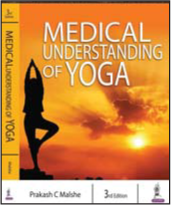Translate this page into:
Book Review: Medical Understanding of Yoga
[To cite: Modi GK. Medical understanding of yoga (Book Review). Natl Med J India 2023:36:395. DOI: 10.25259/NMJI_1227_2023]
Medical Understanding of Yoga. Fourth edition. Prakash C. Malshe. Notion Press, Chennai. 342pp, ₹575. ISBN 979–8890– 26670–5.

Yoga is synonymous with ancient Indian wisdom and heritage. In the past few decades, yoga has become increasingly popular both in India and across the world. The key principles of yoga seem coherent and reasonable for preservation of health and in management of diseases too. This combined with it being a knowledge coming down from many centuries has driven proponents of yoga and the social media to project it as panacea for all health states. However, it is unfortunate that there is still a scarcity of published scientific literature in this field. A Pubmed search with ‘Yoga’ as the search term delivers only 8000 articles of which only around 1200 are clinical trials. This leaves a huge void of validated or tested content in this field. In this context, the efforts of Dr Malshe, a physician in a tier-2 city, are laudable for several years of his study and practice of yoga and quasi-experimental efforts to bring out this book.
The book is organized into discrete but interconnected sections that cover the yogic practices across all sub-domains. Each section starts with citations of Sanskrit texts from the original scriptures and sources followed by the translations. And on this foundation, the author builds up the narrative based on his experience and interpretations in light of current medical knowledge. This makes the reading lucid and connects the reader to the very source of this knowledge while allowing it to gel with the modern-day understanding. The author deftly makes a point that the original context or knowledge in those times might have forced the proponents to make abstractions which should ideally generate hypotheses and not become a basis for rejection of the proposed benefits or practices of yoga.
The author has elegantly mentioned about ancient concepts of yoga and human body that cannot be verified or are difficult to conceptualize and then gently moved ahead without making them necessary or limiting for further discourse. Similarly, to preserve the rigor of the narrative, some of the regularly used terms which do not have any basis have been done away with. To quote from the text from page 15: ‘In the same way, the diagrams of the 6 cakras and the various nâdîs might have been concepts useful to explain various physiological phenomena. The concepts such as those of an “astral body”, “causal body”, “kundalinî”, cakras, nâdîs etc., are all abstract and have not been seen in the firsthand study by dissection on cadavers and by the study of Physiology by direct experimentations, either’ or from page 16: ‘Here I have tried to refrain from using such terms as “prânic energy”, “detoxification”, “purification”, etc. which have no foundation in modern science and draw hard criticism…’
The section on Asanas is well written for anyone wanting to indulge in the practice of Asanas, elaborating on the preparations, technique, physiology and purported benefits. Similarly, the sections on various Kriyans and Pranayams are exhaustive in details and are written in a language that is easy to relate to.
The author has attempted to integrate yogic practices with a wide spectrum of medical knowledge, science and disease states ranging from ‘Possible effects of yoga on human physiology’ starting on page 56 that goes into cellular actions and transmitters, to mention of exposing out plans to sunshine where the skin is more permeable to ultraviolet rays, hormone-sensitive lipases and fasting, hypoxia and growth factors, modulating autonomic nervous system, activation of non-shivering thermogenesis by forceful voluntary breath-holding, uses of filling the intestines with air for control of Helicobacter infection to inhibition of the gastric hormone ghrelin and release of the gut hormone GLP-1, and instant voluntary activation of sympathetic nervous system by mûlabandha and the use of PET scans. He goes on to expound on yogic practices in disorders ranging from psychiatric domain to cardiovascular, lifestyle and ageing.
There are areas where the book could be improved further. It is evident that the author has done extensive study, but at places the references have not been cited as generously. Some of the conclusions about benefits are rather strongly worded for the data available. It seems unintended, but could be changed in the subsequent editions of the book. The picture quality can also be improved.
Unequivocally, this book is a valuable addition to the existent literature because it is the confluence of his medical training, scientific quest and practice that curates what he brings out in his book. The author has amalgamated his faith, personal experience of many years, written word in ancient texts, the scientific method and his own understanding of medial physiology along side philosophical discourses. This allows the reader to step out of his/her own belief systems or prejudices to try to understand or validate the concepts or practices of yoga. The actual scientific method and the specific benefit of yoga for society needs large scientific studies conducted with due rigor. This is the task of institutions that are responsible for public health, research and are custodians to the vast amount of knowledge in our scriptures. They should conduct studies that span from basic sciences to clinical trials.
Dr Malshe deserves compliments for generating so many study questions or hypotheses in his book. While he has listed some key research questions, the main text has far too many areas that can investigated. Every benefit of yoga is valuable because unlike modern medical therapeutics it is accessible and affordable for all.
Overall, this is a well-written, easily understood and comprehensive book on yoga in the current context and will be useful for a wide variety of students, professionals, institutions and lay people too.




